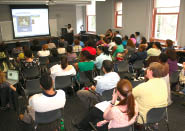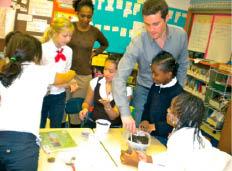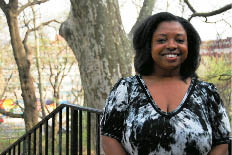Joining Forces
TC is partnering with 10 local public schools to improve education
in science, technology, engineering and math
During preparation time for a lesson at New York City’s P.S. 161, TC’s Ellen Meier, Associate Professor of Computing and Education; and Rita Sanchez Gonzalez, a Ph.D. student in math education, are observing three science teachers practice a sixth-grade experiment on what causes seasons.
The lesson, designed by Sanchez and the teachers, involves taping temperature probes and light sensors to two different spots on a globe and connecting the sensors to a laptop computer. The teachers slowly move the globe around a stationary light bulb to simulate a year of season changes. The computer charts and compares temperatures and the amount of light on each hemisphere. It projects figures onto a screen in the front of the classroom illustrating why, when it is spring in New York, it is fall on the other side of the globe, in Santiago, Chile.
“We work with the teachers to develop project-based activities,” Meier says. “We don’t just talk to the teachers about what to do. We engage them in designing activities, infusing technology in ways that help students build new content knowledge.”
Learning by doing is key to TC’s approach in its Harlem Schools Partnership (HSP), a collaboration between the College and 10 public schools in northern Manhattan focused on the STEM disciplines (science, technology, engineering and math).
“The aim of the HSP is to address the immediate needs of schools by matching our expertise with schools’ goals,” says TC alumna Janell N. Catlin, Adjunct Professor of Science Education and Project Director for the Partnership, which is funded by a five-year, $5-million grant from the General Electric Foundation.
In addition to P.S. 161, also called Don Pedro Albizu Campos, the other Harlem Partnership schools are Public Schools 36, 153, 28, 154, 76, 161 and 180; Intermediate School 195, Heritage High School (680) and A. Philip Randolph High School (540). The work is designed to help teachers improve their instruction in the STEM disciplines, in which African-American and Latino teachers are underrepresented. Science, in particular, has been overlooked in many schools in favor of reading and math in light of extensive high-stakes testing. To meet the goals of the project, the Partnership provides TC faculty and students with opportunities for outreach to the Partnership schools.
Along with Meier, the core TC faculty members supporting the Partnership are, in Science Education, Christopher Emdin, Felicia Moore Mensah and Ann Rivet; in Math Education, Alexander Karp and Erica Walker; and in International and Transcultural Studies, Regina Cortina (see faculty profiles on page 52). They and their TC students are in the Partnership schools, weekly. Collaborators in the Partnership include the Fu Foundation School of Engineering and Applied Science at Columbia, which provides several after-school activities in HSP schools, the New York City Department of Education, and the Morningside Area Alliance.
The Partnership formally kicked off last spring when Catlin and HSP principal investigator Nancy Streim hosted more than 50 educators from the participating schools for a full-day workshop. While there were some clinics and demonstrations by the TC faculty members, the focus was also on learning what the teachers’ needs were.
In the fall, the Partnership ran a workshop series for elementary school teachers. This summer, Catlin is planning a summer institute on inquiry-based practices and an upcoming fall science content course for HSP participants.
Meanwhile, the TC faculty members have gone into the individual schools to help the principals and teachers assess their needs. That effort has been followed by a collaborative design of classroom projects and school-wide initiatives. For example, at the Heritage School—an arts-themed high school founded more than a decade ago by a TC faculty member Judith Burton—Alexander Karp and Erica Walker are developing a two-pronged peer math tutoring initiative for students as well as teachers. The peer tutoring program for students involves high-achieving high school students tutoring their peers, supervised by teachers and a team of graduate students, after school three days per week.
Eventually, the peer tutoring program for teachers will result in an online resource for teachers, across the Partnership and beyond, where they can connect with one another and share knowledge. Karp and Walker and their team of graduate students are collecting data about tutors’ and teachers’ practice, and students’ mathematical difficulties, to develop a map for organizing teacher-led seminars that focus on enhancing student understanding of mathematics.
Also at the Heritage School, Emdin and Alissa Berg, a doctoral student in science education, have started a voluntary after-school science club that meets weekly. “We’ve made ice cream to illustrate freezing and melting points, and solvents,” Emdin says. “We’ve conducted exciting lab experiments to see the reaction of the chemicals.” Just five students showed up to the first meeting in November, but this spring the club regularly drew as many as 30.
At Public Schools 36 and 180, Moore Mensah and her team of graduate students employ FOSS (Full Option Science System) kits supplied by the New York City Department of Education and produced by the Lawrence Hall of Science, University of California at Berkeley. “The FOSS kits provide grade-specific, hands-on activities and curricular concepts,” Moore Mensah says. TC students in her Science Methods class also observe the Partnership teachers for six weeks and keep a journal, then plan and teach science lessons drawn from classroom observations and student interviews. “It’s a great opportunity to give pre-service students experience teaching science in urban classrooms,” says Moore Mensah, “and they get to see good science being taught.”
The Partnership’s collaborative teaching style can be jarring to educators who were trained to lecture in front of the classroom to rows of silent students. To underscore that point, Meier tells a story, possibly apocryphal, about a principal who comes to a classroom to observe the teacher. The principal finds students working in small groups around computers, while the teacher moves from group to group, listening to the students and posing provocative questions. “Oh,” the principal says to the teacher, “I’ll come back when you’re teaching.”
It doesn’t take long, though, before the mutual benefits of such a collaborative approach become apparent. As Catlin sees it, those benefits cut both ways.
“We have this great institution, with great minds, with students who are willing to invest in the community, and so we need to service the area in which we are situated,” she says. “Meanwhile, we’re supporting our faculty and our students in doing the kind of work that is important to them. This is the future of successful urban communities.”
Published Thursday, May. 20, 2010




